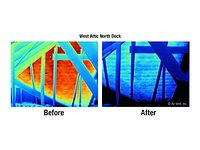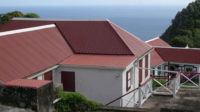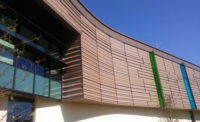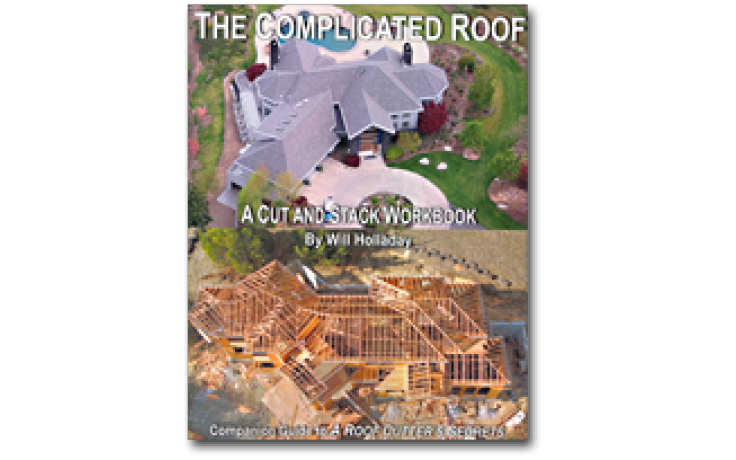Since their introduction into the residential roofing marketplace just a few years ago, premium self-adhering underlayments made of SBS-modified asphalt have been broadly adopted, applauded and accepted by roofing contractors. As a result, most contractors now are familiar with various types of self-adhering underlayments and their installation, especially with regard to their use under asphalt shingles.
Another closely watched application for premium underlayments is in metal roofing, for both commercial and residential buildings, where the number of successful applications is growing daily. This application is an ideal match because it combines the watersealing performance of premium underlayments with the physical ruggedness of a metal rooftop.
Premium underlayments are not meant for use as a primary roof. The combination of direct sunlight, ultraviolet radiation and rain or snow would alternately oxidize and wash away the asphalt-rubber blend and the membrane, causing it to fail. Underlayments protect the building from water damage when the primary roof leaks. Usually, even damaged primary roofs continue to protect the underlayment from physical harm and UV rays, so underlayments can be highly effective as a last line of defense until there is an opportunity to make repairs.
As with any successful new technology, product differentiation occurs in the marketplace. There are differences between corresponding products from different manufacturers, as well as extensions of manufacturers' product lines. This product differentiation presents roofing contractors with a bewildering number of choices.
A previous article in Roofing Contractor covered the use of premium self-adhering underlayments with reference mainly to their use under asphalt shingles in residential applications (See "The Extra Protection Every Roof Needs," by Steve Ratcliff, Roofing Contractor, August 2002). The present article describes the various product categories now on the market, with particular emphasis on premium self-adhering underlayments for metal roofing and how these membranes differ from others.

Similarities
Perhaps it is best to start the comparison by examining what is similar from product to product. Nearly all of the so-called "premium underlayments" are made of a blend of asphalt and styrene-butadiene-styrene (SBS), which is a rubber-like polymer not unlike chewing gum.SBS soaks up the asphalt much like a sponge soaks up water. The asphalt provides waterproofing while the SBS lends flexibility to the asphalt at cold temperatures and hinders the flow of the asphalt at warm temperatures. The SBS-asphalt blend is a miracle of polymer science that has been many years in the making.
This SBS-asphalt blend is coated onto a fiberglass mat and processed into a sheet, or membrane, which resists water yet is easy to apply. The tough fiberglass mat embedded in the rubber-asphalt blend gives strength against rips and tears and makes the underlayment easy to handle. More important, the SBS-asphalt blend imparts flexibility and resilience to the membrane. As a result, the underlayment is self-sealing around nails. Imagine driving a nail through a rubber ball. The flexible membrane pushes tightly against the nails, blocking moisture from penetrating.
The thickness of typical premium self-adhering underlayments ranges from 40 to 60 mils (1.0 mm to 1.5 mm). Premium underlayments typically are much thicker and heavier than asphalt-saturated organic felts, asphalt-coated fiberglass, and other conventional roll roofing products; however, the chemical composition, rather than the thickness or weight, is what makes the difference between premium and conventional products.
The Sticky Underbelly
An important benefit of a premium underlayment - from the roofing contractor's point of view - is its tacky underside. Generally known as "peel-and-stick" products, the SBS-modified asphalt on the bottom side is covered with a split-back release film that can be peeled off to expose the sticky surface.Depending on the product, manufacturer and ambient temperature, this surface can range from tacky to gooey. It adheres directly to concrete, plywood, wood composition-board, and gypsum-sheathing decks. Concrete masonry and fiberglass-faced gypsum surfaces first need to be primed to ensure adhesion. Quantitatively, the material's tackiness is measured in terms of an adhesion force according to ASTM D-1970. For example, LeakBarrier Ice and Water Armor underlayment from Tarco, has an adhesion force to plywood of 30 lbf/foot of width at 75 degrees F and 18 lbf/foot of width at 40 degrees F (for 36-inch width).
To account for different climates and seasons, allowing for easier installation, some manufacturers offer premium underlayments in two grades: summer and winter. Regardless of the grade, warm weather conditions are best for good adhesion. Application should be made when the ambient temperatures are 40 degrees F or above. The availability of two grades tailored to the ambient application temperatures eases the installation, because of the different viscosities of the two grades. The winter grade is stickier than the summer grade at cooler temperatures and, likewise, the summer grade is less viscous at warmer temperatures. Roofing contractors would use the summer grade all year in the Sunbelt, but they would switch to the winter grade for installations taking place during cooler months in the Northern climates.
The "right" amount of tack can be subjective, and preferences vary among roofers. Some contractors prefer lower adhesion, which allows for easier re-alignment if the sheets are initially misplaced; others prefer stronger adhesion to ensure a good grip to a particular material or slope. For many installers it is a matter of what feels right, and one membrane is often chosen over another because of the contractor's familiarity with the product.
The tacky surface of premium underlayments is a labor-saving feature, which allows contractors to add value while minimizing added labor. Contractors can offer homeowners a premium upgrade without a major increase in the overall job cost.
Depending on the roof specification (including type of deck, type of primary roof, slope of roof, and other factors) nailing the underlayment might or might not be necessary. In any case, once the sticky bottom-side of the SBS-modified asphalt membrane seals against the deck, chances of a leak spreading later on are greatly reduced.
There are SBS-modified asphalt underlayments available without the sticky underside. For example, Tarco makes a modified asphalt fiberglass reinforced sheet (under the product name LeakBarrier SBS MultiPurpose Underlayment) that is an alternative to traditional organic saturated felt.
Most contractors prefer the convenience of self-adhering (peel-and-stick) membranes for residential and metal roofing applications, especially in residential markets where the use of hot mopping and cold-applied adhesives is rare.
What's the Difference?
visible difference is the surfacing. Some of these products have a sanded surface; others have a mineral surface; and some have a polymer film surface.For example, Tarco's mineral surface (MS) underlayment meets the requirements for slip or skid resistance as defined by ASTM-1970. It offers maximum skid resistance and therefore increased installer safety. The MS product is suitable for most residential applications, except metal, and it is especially suitable for roofs with slopes greater than 4:12 pitch. The sand surface (SS) product also offers good surface traction, which makes it an excellent choice for tile and shingle applications.
The main weight and thickness difference among the three types of underlayment is seen in the polymer surface (PS) product. A 2-square roll of PS underlayment typically weighs about 30 pounds less than a 2-square roll of MS underlayment. The PS type also provides ample skid resistance for most applications, including metal, tile, slate and asphalt shingle applications. PS products differ in other ways from the other types of premium underlayments. For metal roofing applications, these additional properties are extremely important.
The major difference among these various types of underlayments is not immediately visible because it involves the compound stability. The polymer surface self-adhering underlayment was specifically formulated to provide high-temperature stability up to 260 degrees F as measured by ASTM D-5147. This high softening temperature is important for metal roofing, which will be explained in detail further on.

Membranes Under Metal
Metal roofs, though they often provide many decades of trouble-free service, are not immune to leaks. Wind-blown rain can make its way under metal shingles and unsealed standing-seam metal roofs. Ice dams force open channels that allow water under the metal skin. Metal roofs also can be compromised by installation errors, accidental penetrations, foot traffic, corrosion or stresses due to thermal expansion.When leaks do occur, a second line of defense can help prevent significant damage to the entire structure. Today, many metal roof installers include a self-adhering, watertight underlayment as this secondary defense. And why not? It is both good for their customers and good for their reputation. They may install this extra protection under the entire primary roof or under the most vulnerable areas, such as in valleys or along eaves where ice dams typically develop.
Temperatures under a metal or tile roof can be very high. Conventional organic roll roofing felts tend to break down under these conditions of extreme heat. In the past, in many cases, metal or tile roofs have failed because of the underlayment. It is not uncommon, for example, for original tiles to be re-used after the underlayment has been replaced.
Metal or tile is usually selected for architectural or aesthetic reasons. Such premium, architectural roofs are often customized to the building. It makes sense to use a premium underlayment beneath a premium roof. Also, the cost of labor for installing a roof can easily exceed the cost of materials. The additional cost for premium underlayment compared to conventional roll roofing is minor in comparison to the installation cost of the entire roof. These considerations favor the use of premium underlayments beneath metal and tile.
Mod Bit Problems
Modified bitumens have been used as underlayments for metal roofs in the past, but there were several drawbacks associated with them. The first has to do with the high temperatures that are reached beneath a metal roof. In direct sunlight these roofs become quite hot, and this heat is conducted to the underlayment. Aluminum or copper roofs, and dark-colored painted steel roofs, can be hot enough to cause SBS-modified bitumen to melt and drip down the side of the building. In metal roofing applications, it is critical that the underlayment used must have the ability to withstand high temperatures. Also, the SBS-asphalt blend must remain stable at these temperatures.
Because a metal roof can get hotter than a black asphalt-shingle roof, underlayments for metal roofing must resist flow at even higher temperatures. To meet this requirement, the PS type of premium underlayment from Tarco, for example, has been formulated to remain stable to at least 260 degrees F, which is well above even the highest temperatures found on roofs under extreme heat conditions.
Stretching and Sticking
Another problem with metal is that its rate of thermal expansion is much higher than that of other materials. Combined with bitumen oozing, this can cause a sticky situation. The oozing mod-bit can glue the underlayment to the underside of the metal roof, which results in tearing as the metal roof expands.The larger the roof surface, the greater the expansion - which places significant strain on the underlayment. Even if the bitumen-oozing problem is resolved, friction between sanded or mineral surfaces and a metal roof can damage the underlayment as well as the roof. As the metal repeatedly expands and contracts, the granules act like sand paper, abrading the underside of the roof, removing the anticorrosion layer and exposing the metal to corrosion.
Experience shows that a polymer surface underlayment is the best choice for use under large metal roofs, particularly in commercial applications. The polymer provides adequate slip resistance for installers, yet it easily slides beneath the metal roofing, and it is too soft to abrade the metal. At the same time, the smooth polymer surface provides better contact with the metal roof, improving heat conduction from the roof to the deck, which helps to reduce the peak temperatures. This combination of polymer surface and compound stability in one premium, self-adhering membrane results in a trouble-free underlayment for metal roofs.
Vapor Barrier
Often, metal roof systems that fail due to corrosion actually rust from the inside out, the result of condensation on the metal's underside. One way to prevent this is to cover the entire roof deck with a premium underlayment, which prevents moisture from forming beneath the metal.
Whenever a vapor retarder is installed under an entire roof system, adequate ventilation must be provided within the attic space. In similar circumstances, watertight underlayments also require proper ventilation, including both ridge and soffit venting. If these precautions are observed, the use of waterproofing underlayments with metal roofs is an attractive option for both the contractor and the building owner.
Building Owner Satisfaction
Building owner satisfaction is important to a contractor's reputation and critical for his success. Before SBS-membranes, a leak in the primary roof could be catastrophic for the building owner. There was not much protection between the primary roof (metal, tile or shingle) and the roof deck. Therefore, from the owner's perspective, the most important attribute of a self-adhering underlayment is waterproofing. A premium underlayment may be the only defense against the elements when there is a breach in the primary roof. This advantage applies to shingles in a small, steep-sloped residential application as well as to large metal roofs over commercial buildings.With today's modified-asphalt membranes, the likelihood of a catastrophic failure is greatly reduced, even when there is a penetration of the primary roof. Like the roof systems installed above them, premium underlayments can last for decades if properly covered. This combination of waterproofing underlayment and a physically rugged primary roof provides a degree of confidence in roofing systems that has been unattainable in the past.
Although the market for underlayments under metal roofs is not as large as that for shingles, the use of self-adhering premium underlayments underneath metal roofing, for both residential and commercial applications, represents an important advancement in job quality, security and performance. Square-for-square and dollar-for-dollar, self-adhering SBS-modified-asphalt underlayments are one of the best values in construction materials today.





